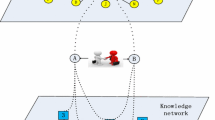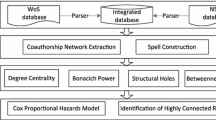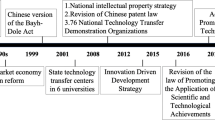Abstract
Knowledge is a crucial asset in organizations and its diffusion and recombination processes can be affected by numerous factors. This study examines the influence of the status of individual researchers in social networks on the knowledge diffusion and recombination process. We contend that knowledge diversity, random diffusion, and parallel duplication are three primary factors characterizing diffusion paths in knowledge networks. Using multiple social network measures, we investigate how individuals in the respective institutional collaboration networks influence knowledge diffusion through scientific papers. Scientific publication data and citation data from six prolific institutions in China (Chinese Academy of Sciences) and the United States (University of California at Berkeley, University of Illinois, Massachusetts Institute of Technology, Northwestern University, and Georgia Institute of Technology) in nanotechnology field in the interval 2000–2010 were used for empirical analysis, and the Cox regression model was leveraged to analyze the temporal relationships between knowledge diffusion and social network measures of researchers in these leading institutions. Results show that structural holes and degree centrality are the most effective measures to explain the knowledge diffusion process within these six institutions. Knowledge recombination is mainly achieved through parallel duplication within groups and recombination of diverse knowledge across different groups. The results are similar for all six institutions except for Bonacich power and eigenvector measures, which may posit cultural difference across countries and institutions.


Similar content being viewed by others
References
Abbasi, A., Chung, K. S. K., & Hossain, L. (2012). Egocentric analysis of co-authorship network structure, position and performance. Information Processing and Management, 48(4), 671–679.
Agrawal, A., Cockburn, I. M., & McHale, J. (2006). Gone but not forgotten: Knowledge flows, labor mobility, and enduring social relationships. Journal of Economic Geography, 6, 571–591.
Ahuja, G. (2000). The duality of collaboration: Inducements and opportunities in the formation of interfirm linkages. Strategic Management Journal, 21(3), 317–343.
Albert, R., & Barabasi, A. L. (2002). Statistical mechanics of complex networks. Reviews of Modern Physics, 74(1), 47.
Allison, P. D. (1995). Survival analysis using SAS: A practical guide. AMC, 10, 12.
Breitzman, A., & Thomas, P. (2015). Inventor team size as a predictor of the future citation impact of patents. Scientometrics. doi:10.1007/s11192-015-1550-5.
Bonacich, P. (1987). Power and centrality: A family of measures. American Journal of Sociology, 92, 1170–1182.
Bonacich, P., & Lloyd, P. (2001). Eigenvector-like measures of centrality for asymmetric relations. Social Networks, 23(3), 191–201.
Borgatti, S. P. (2005). Centrality and network flow. Social Networks, 27, 55–71.
Borgatti, S. P., Everett, M. G., & Johnson, J. C. (2013). Analyzing social networks. Thousand Oaks: Sage.
Borgatti, S. P., Everett, M. G., & Freeman, L. C. (2002). UCINET for windows: Software for social network analysis. Harvard: Analytic Technologies.
Börner, K., Penumarthy, S., Meiss, M., & Ke, W. M. (2006). Mapping the diffusion of scholarly knowledge among major US research institutions. Scientometrics, 68(3), 415–426.
Burt, R. (1992). Structural holes: The social structure of competition. Cambridge, MA: Harvard University Press.
Cheang, B., Li, C., Lim, A., & Zhang, Z. Z. (2015). Identifying patterns and structural influences in the scientific communication of business knowledge. Scientometrics, 103, 159–189.
Chen, H., Roco, M. C., & Son, J. (2013). Nanotechnology public funding and impact analysis: A tale of two decades (1991–2010). IEEE Nanotechnology Magazine, 7(1), 9–14.
Chesbrough, H. W., & Teece, D. J. (1996). When is virtual virtuous? Harvard Business Review, 74(1), 65–73.
Cohen, W. M., & Levinthal, D. A. (1990). Absorptive capacity: A new perspective on learning and innovation. Administrative Science Quarterly, 35(1), 128–152.
Cox, D. R. (1992). Regression models and life-tables. Breakthroughs in statistics (pp. 527–541). New York: Springer.
Cummings, J. N. (2004). Work groups, structural diversity, and knowledge sharing in a global organization. Management Science, 50(3), 352–364.
Danneels, E. (2002). The dynamics of product innovation and firm competences. Strategic Management Journal, 23, 1095–1121.
Estabrooks, C. A., Derksen, L., Winther, C., Lavis, J. N., Scott, S. D., Wallin, L., & McGrath, J. P. (2008). The intellectual structure and substance of the knowledge utilization field: A longitudinal author co-citation analysis, 1945 to 2004. Implementation Science, 3, 49.
Fleming, L. (2001). Recombinant uncertainty in technological search. Management Science, 47(1), 117–132.
Fleming, L., Mingo, S., & Chen, D. (2007). Collaborative brokerage, generative creativity, and creative success. Administrative Science Quarterly, 52(3), 443–475.
Freeman, L. C. (1979). Centrality in social networks: Conceptual clarification. Social Networks, 1, 215–239.
Freeman, L. C., Borgatti, S. P., & White, D. R. (1991). Centrality in valued graphs: A measure of betweenness based on network flow. Social Networks, 13, 141–154.
Friedkin, N. E. (1991). Theoretical foundations for centrality measures. American Journal of Sociology, 96, 1478–1504.
Guan, J., & Zhu, W. (2014). How knowledge diffuses across countries: A case study in the field of management. Scientometrics, 98(3), 2129–2144.
Gossart, C., & Özman, M. (2009). Co-authorship networks in social sciences: The case of Turkey. Scientometrics, 78(2), 323–345.
Haas, M. R., & Hansen, M. T. (2007). Different knowledge, different benefits: Toward a productivity perspective on knowledge sharing in organizations. Strategic Management Journal, 28(11), 1133–1153.
Hanneman, R. A., & Riddle, M. (2005). Introduction to social networks methods. Riverside: University of California.
Huang, Z., Chen, H., Chen, Z. K., & Roco, M. C. (2004). International nanotechnology development in 2003: Country, institution, and technology field analysis based on USPTO patent database. Journal of Nanoparticle Research, 6(4), 325–354.
Jiang, S., Gao, Q., & Chen, H. (2013). Statistical modeling of nanotechnology knowledge diffusion networks. In 34th international conference on information systems, Milan, Italy.
Kaza, S., & Chen, H. (2010). Identifying high-status nodes in knowledge networks//data mining for social network data (pp. 91–107). New York: Springer.
Kiss, I. Z., Broom, M., Craze, P. G., & Rafols, I. (2010). Can epidemic models describe the diffusion of topics across disciplines? Journal of Informetrics, 4, 74–82.
Kleinbaum, D. G., & Klein, M. (1996). Survival analysis. New York: Springer.
Leydesdorff, L., & Rafols, I. (2009). A global map of science based on the ISI subject categories. Journal of the American Society for Information Science and Technology, 60(2), 348–362.
Li, X., Chen, H., Dang, Y., Lin, Y., Larson, C. A., & Roco, M. C. (2008). A longitudinal analysis of nanotechnology literature: 1976–2004. Journal of Nanoparticle Research, 10(1), 3–22.
Liu, X., Bollen, J., Nelson, M. L., & Sompel, H. V. (2005). Co-authorship networks in the digital library research community. Information Processing and Management, 41, 1462–1480.
Liu, X., Kaza, S., Zhang, P. Z., & Chen, H. (2011). Determining inventor status and its effect on knowledge diffusion: A study on nanotechnology literature from China, Russia, and India. Journal of the American Society for Information Science and Technology, 62(6), 1166–1176.
Liu, X., Zhang, P. Z., Li, X., Chen, H., Dang, Y., Larson, C. A., … Wang, X. W. (2009). Trends for nanotechnology development in China, Russia, and India. Journal of Nanoparticle Research, 11(8), 1845–1866.
Liu, Y. X., & Rousseau, R. (2010). Knowledge diffusion through publications and citations: A case study using ESI-fields as unit of diffusion. Journal of the American Society for Information Science and Technology, 61(2), 340–351.
McFadyen, M. A., & Cannella, A. A. (2004). Social capital and knowledge creation: Diminishing returns of the number and strength of exchange relationships. Academy of Management Journal, 47(5), 735–746.
McFadyen, M. A., Semadeni, M., & Cannella, A. A. (2009). Value of strong ties to disconnected others: Examining knowledge creation in biomedicine. Organization Science, 20(3), 552–564.
Nahapiet, J., & Ghoshal, S. (1998). Social capital, intellectual capital, and the organizational advantage. Academy of Management Review, 23(2), 242–266.
Nerkar, A., & Paruchuri, S. (2005). Evolution of R&D capabilities: The role of knowledge networks within a firm. Management Science, 51(5), 771–785.
Newman, M. E. J. (2005). A measure of betweenness centrality based on random walks. Social Networks, 27, 39–54.
Newman, M. E. J., Watts, D. J., & Strogatz, S. H. (2002). Random graph models of social networks. Proceedings of the National Academy of Sciences of the United States of America, 99(Suppl 1), 2566–2572.
Ozel, B. (2012). Collaboration structure and knowledge diffusion in Turkish management academia. Scientometrics, 93(1), 183–206.
Patrakosol, B., & Olson, D. L. (2007). How interfirm collaboration benefits IT innovation. Information & Management, 44(1), 53–62.
Phelps, C. C. (2010). A longitudinal study of the influence of alliance network structure and composition on firm exploratory innovation. Academy of Management Journal, 53(4), 890–913.
Phelps, C., Heidl, R., & Wadhwa, A. (2012). Knowledge, networks, and knowledge networks a review and research agenda. Journal of Management, 38(4), 1115–1166.
Podolny, J. M., & Stuart, T. E. (1995). A role-based ecology of technological change. American Journal of Sociology, 100, 1224–1260.
Reagans, R., & Ezra, W. Z. (2001). Networks, diversity, and productivity: The social capital of corporate R&D teams. Organization Science, 12(4), 502–517.
Reagans, R., & McEvily, B. (2003). Network structure and knowledge transfer: The effects of cohesion and range. Administrative Science Quarterly, 48(2), 240–267.
Roco, M. C., & Bainbridge, W. S. (2013). The new world of discovery, invention and innovation: Convergence of knowledge, technology and society. Journal of Nanoparticle Research, 15(1946), 1–17.
Rowlands, I. (2002). Journal diffusion factor: A new approach to measuring research influence. Aslib Proceedings, 54(2), 77–84.
Salomon, R., & Martin, X. (2008). Learning, knowledge transfer, and technology implementation performance: A study of time-to-build in the global semiconductor industry. Management Science, 54(7), 1266–1280.
Schilling, M. A., & Phelps, C. C. (2007). Interfirm collaboration networks: The impact of large-scale network structure on firm innovation. Management Science, 53(7), 1113–1126.
Scott, J. (2000). Social network analysis: A handbook (2nd ed.). London: Sage.
Shan, W. J., Walker, G., & Kogut, B. (1994). Interfirm cooperation and startup innovation in the biotechnology industry. Strategic Management Journal, 15(5), 387–394.
Singh, J. (2005). Collaborative networks as determinants of knowledge diffusion patterns. Management Science, 51(5), 756–770.
Singh, J., & Marx, M. (2013). Geographic constraints on knowledge spillovers: Political borders vs. spatial proximity. Management Science, 59(9), 2056–2078.
Sorenson, O., & Stuart, T. E. (2001). Syndication networks and the spatial distribution of venture capital investments. American Journal of Sociology, 106(6), 1546–1588.
Stephenson, K., & Zelen, M. (1989). Rethinking centrality: Methods and examples. Social Networks, 11(1), 1–37.
Taba, S. T., Hossain, L., Atkinson, S. R., & Lewis, S. (2015). Towards understanding longitudinal collaboration networks: A case of mammography performance research. Scientometrics, 103, 531–544.
Tiwana, A. (2008). Do bridging ties complement strong ties? An empirical examination of alliance ambidexterity. Strategic Management Journal, 29(3), 251–272.
Tsai, W. (2001). Knowledge transfer in intraorganizational networks: Effects of network position and absorptive capacity on business unit innovation and performance. Academy of Management Journal, 44(5), 996–1004.
Valente, T. W. (1995). Network models of the diffusion of innovations (Vol. 2). Cresskill, NJ: Hampton Press.
Wang, J. C., Chiang, C., & Lin, S. W. (2010). Network structure of innovation: Can brokerage or closure predict patent quality? Scientometrics, 84(3), 735–748.
Wasserman, S., & Faust, K. (1994). Social network analysis: Methods and applications. New York, NY: Cambridge University Press.
Zhu, Y. J., & Yan, E. (2015). Dynamic subfield analysis of disciplines: An examination of the trading impact and knowledge diffusion patterns of computer science. Scientometrics. doi:10.1007/s11192-015-1594-6.
Zucker, L. G., & Darby, M. R. (1996). Star scientists and institutional transformation: Patterns of invention and innovation in the formation of the biotechnology industry. Proceedings of the National Academy of Sciences, 93(23), 12709–12716.
Acknowledgments
This study was supported by the US National Science Foundation (CMMI-1057624 and CMMI-1249210), and the National Natural Science Foundation of China (Grants Nos. 71471064,71101053, 61104139, 71171131, and 71103021), and also sponsored by Shanghai Pujiang Program (Grant No. 15PJC019). The last co-author was supported by the Directorate of Engineering, NSF. The literature data was purchased from Thomson ISI and we thank them for their support.
Author information
Authors and Affiliations
Corresponding author
Appendix
Appendix







Rights and permissions
About this article
Cite this article
Liu, X., Jiang, S., Chen, H. et al. Modeling knowledge diffusion in scientific innovation networks: an institutional comparison between China and US with illustration for nanotechnology. Scientometrics 105, 1953–1984 (2015). https://doi.org/10.1007/s11192-015-1761-9
Received:
Published:
Issue Date:
DOI: https://doi.org/10.1007/s11192-015-1761-9




